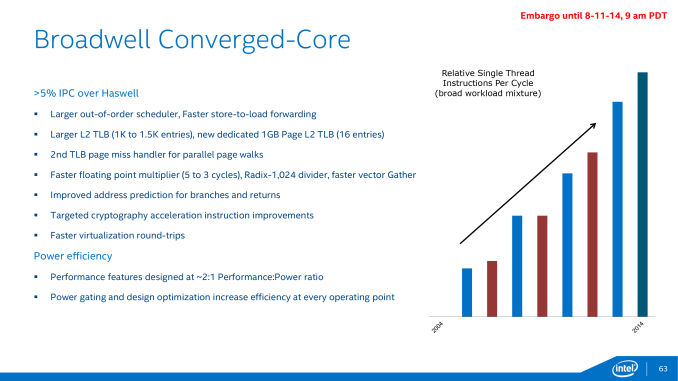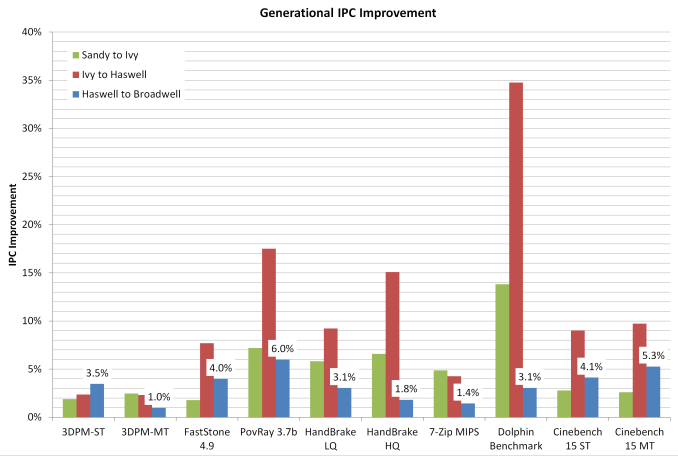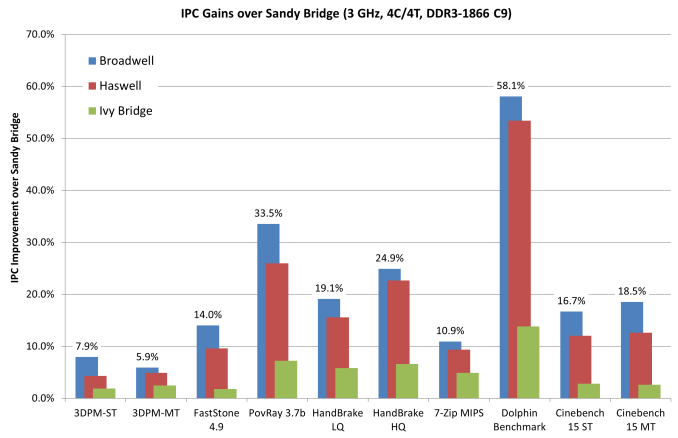The Intel Broadwell Review Part 2: Overclocking, IPC and Generational Analysis
by Ian Cutress on August 3, 2015 8:00 AM ESTConclusions: Broadwell Overclocking, IPC and Generational Gain
For everyone who has been in the PC industry for a decade or more, several key moments stand out when it comes to a better processor in the market. The Core architecture made leaps and bounds over the previous Pentium 4 Prescott debacle, primarily due to a refocus on efficiency over raw frequency. The Sandy Bridge architecture also came with a significant boost, moving the Northbridge on die and simplifying design.
Since then, despite the perseverance of (or soon to be mildly delayed) Moore’s Law, performance is measured differently. Efficiency, core count, integrated SIMD graphics, heterogeneous system architecture and specific instruction sets are now used due to the ever expanding and changing paradigm of user experience. Something that is fast for both compute and graphics, and then also uses near-zero power is the holy-grail in design. But let’s snap back to reality here – software is still designed in code one line at a time. The rate at which those lines are processed, particularly in response driven scenarios, is paramount. This is why the ‘instructions per clock/cycle’ metric, IPC, is still an important aspect of modern day computing.
As the movement from Haswell to Broadwell is a reduction in the lithography node, from 22nm to 14nm, with a few silicon changes, Broadwell was a mobile first design and launched in late 2014 with notebook parts. This is typical with node reductions due to the focus on efficiency overall rather than just performance. For the desktop parts, launched over six months later, we end up with an integrated graphics focused implementation purposefully designed for all-in-one PCs and integrated systems rather than a mainstream, high end processor. The i7 and i5 are both targeted at 65W, rather than 84W/88W of the previous architecture. This gives the CPUs a much lower frequency and without a corresponding IPC change, makes the upgrade path more focused for low end Haswell owners, those who are still several generations behind wanting an upgrade or those who specifically want an integrated graphics solution.
In our first look at Broadwell on the desktop, our recommendation that it would only appeal to those who need the best integrated graphics solution regardless of cost still stands. Part 2 has revealed that clock-for-clock, Broadwell gives 3.3% better performance from our tests although DRAM focused workloads (WinRAR) can benefit up to 25%, although those are few and far between. If we compare it back several generations, that small IPC gain is wiped out by processors like the i7-4790K that overpower the CPU performance in pure frequency or even the i7-4770K which still has a frequency advantage. From an overall CPU performance standpoint out of the box, the i7-5775C sits toe-to-toe with the i7-4770K with an average 1% loss. However, moving the comparison up to the i7-4790K and due to that frequency difference, the Broadwell CPU sits an average 12% behind it, except in those specific tests that can use the eDRAM.
There’s nothing much to be gained with overclocking either. Our i7-5775C CPU made 4.2 GHz, in line with Intel’s expectations for these processors. If we compare that to an overclocked 4.6 GHz i7-4790K, the 4790K is still the winner. Overclocking on these Broadwell CPUs still requires care, due to the arrangement of the CPU under the heatspreader with the added DRAM. We suggest the line method of thermal paste application rather than the large-pea method as a result.
Looking back on the generational improvements since Sandy Bridge is actually rather interesting. I remember using the i7-2600K, overclocking it to 5.0 GHz and remembering how stunned I was at the time. Step forward 4.5 years and we have a direct 21% increase in raw performance per clock, along with the added functionality benefits of faster memory and a chipset that offers a lot more functionality. If you’ve been following the technology industry lately, there is plenty of talk surrounding the upcoming launch of Skylake, an architectural update to Intel’s processor line on 14nm. I can’t wait to see how that performs in relation to the four generations tested in this article.
*When this article was initially published, inaccuracies were made in calculating the IPC gain in the timed benchmarks. The article has been updated to reflect this change. In light of the recalculation,overall conclusions are still correct.
Interesting related links:
The Intel Broadwell Desktop Review: Core i7-5775C and Core i5-5675C Tested (Part 1)
AnandTech Bench CPU Comparison Tool














121 Comments
View All Comments
Shadow7037932 - Monday, August 3, 2015 - link
Still running a i7 920 @ 3.8Ghz on custom water cooling. OS, SSDs, HDDs, GPUs, have all been upgraded since 2009. Still holding it's own in gaming and multithreaded software (video rendering).Also, with the hexacore X5650 being available for around $70-100 used, I can probably breathe a bit more life into this.
milli - Tuesday, August 4, 2015 - link
I invested big time in my X58 platform but it's still going strong. One year ago I upgraded my i7 920 to a Xeon X5650 (which I bought second hand for like $100). Now I have a six core HT 32nm OC'd beast that runs much cooler than my 920. I can't believe this platform is now 7 years old.Jetpil0t - Thursday, August 6, 2015 - link
I have been waiting for so long to upgrade my 2500k an R9 290, was looking at a 6600k and Fury X but for like $2,000 the performance really isn't there. Second hand 290 for $250 will probably be my next upgrade and still faster than a brand new 6600k Fury build. More money for games I guess.michael2k - Monday, August 3, 2015 - link
Is that entirely true? It seems from the graphs that you can expect 10% to 20% improvement in performance at the same clock compared to Sandy Bridge and the Broadwell is a good 30% less in terms of power consumption. In other words the 0.25V difference in overclock is exactly the reason Broadwell consumes 30% less power. Since you don't care about the power then you can clock it up and volt it up and see a 10% to 20% improvement in performance. You can argue that the 10% to 20% improvement isn't worth it, of course. The IPC gains only matter if you care to overclock the Broadwell part.sonny73n - Tuesday, August 4, 2015 - link
"my ivy bridge 3570k does the same clock with 1.075v."1.075v @4.2GHz? Are you sure you didn't mistype? Prime95 stress test?
Jetpil0t - Thursday, August 6, 2015 - link
Still rocking a i5 2500k @ 4.0Ghz and an R9 290 @ 1.1Ghz and it's rockin along no problem, I want to but new shiny things, but there is zero reason to, which is nice for the value but a little odd given the age of this processor. If I had known I was going to be hanging onto this CPU for so long I would have picked up the i7 2600/2700k, but even then, the i5 2500k is a powerhouse, apparently. Just puts into perspective how crazy powerful these CPUs were 5 years ago when they landed.Jetpil0t - Thursday, August 6, 2015 - link
They should just take each of these CPUs to 4.0Ghz locked and bench it out, I bet the 2600k still fires up there with the best of them. The sample used here is still stock, so with an OC it's more or less up there all the way through to a 980ti.Oxford Guy - Thursday, January 21, 2016 - link
Proper Broadwell overclocking appears to require that the EDRAM clock be changed. They didn't do that here, hence the poor result.K_Space - Monday, August 3, 2015 - link
For desktop users the article only consolidated what was already known: hold tight to your Haswell CPU until Skylake (and even then you probably won't need to upgrade). The Z97 chipset is such a mature platform and the high frequency clocked parts have dropped in price. The 4790K is an absolute brute. Haswell -just like Sandy and Nehalem is going to be very stretchy generation.Nagorak - Tuesday, August 4, 2015 - link
Forget that, just hold tight to your Sandy Bridge. Four years running and you can make up most of the difference in IPC by just cranking up the clock. Once you take the lower frequency into account, Broadwell's ~18% improvement drops to only around 10%.